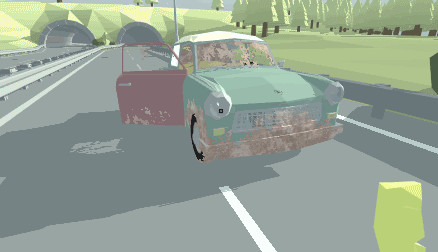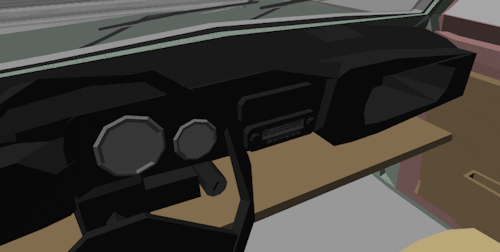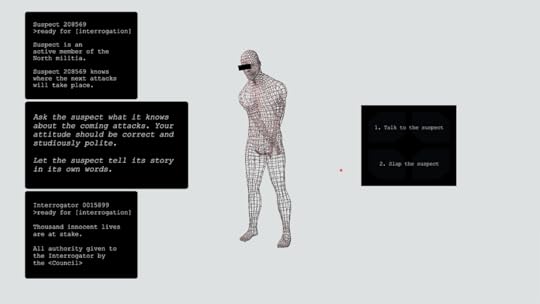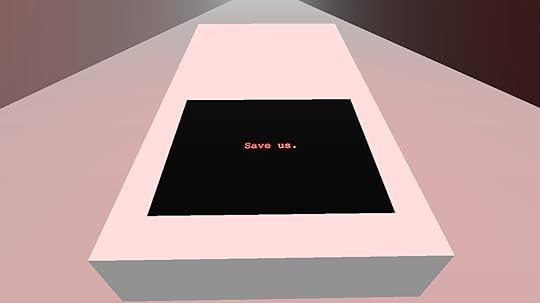Kill Screen Magazine's Blog, page 284
March 6, 2015
Artists are using 3D scanning to create "collaborative self-portraits"
Welcome to the land of philosophical quandaries.
A road-trip game about the fiddly art of vehicle maintenance
Hac (pronounced "Hajj") is a videogame about the worst parts of driving. Washing the mud out of the grill; changing the battery; losing the keys in the space between the door and your seat; packing suitcases and sleeping bags into a trunk that's way too small. More than anything else, it's concerned with simulating all the laborious tasks that take place around and inform the actual activity at hand. The funny thing is this: performing all of these micro-processes is wholly satisfying.
as much of an antithesis to Formula One racing games as you can get
The game's solo creator, Greg Pryjmachuk, worked on the Formula One racing game series at Codemasters for over five years, rehashing the same designs over and over. Understandably, he got a little tired of it. "There's only so many ways a designer can work under the tight constraints of FOM (Formula One Management), likewise, there's only so many ways a player can drive the same car around the same track, year after year," writes Pryjmachuk.
Hac is born of his desire to see what else can be done with cars and the driving of them in videogames. It's about as much of an antithesis to Formula One racing games as you can get while still working loosely within the same genre. As Pryjmachuk describes it, Hac is "Euro Truck Simulator with a narrative." It gives you a week to transport your grumpy, ailing uncle Lütfi to Mecca during the fall of the Eastern Bloc.

It starts you off in a cramped East Berlin apartment—part of a Vertragsarbeiter (contract workers) housing complex—a large brutalist structure that, along with the angular low-poly look, makes visible the oppressive politics of the place. Your first task is to gather the materials for your journey. Empty bottles have to be taken to the tap, the faucet turned, and filled up. You should also arrange tins of food into a small wooden carrier with a view to take as much as possible. None of this is vital: you can leave on your journey without supplies, but you'll probably suffer in the days ahead for this absence. What you cannot leave without, however, is your uncle's suitcase, two sleeping bags, and the car keys.
Once you're satisfied with your haul, you then have to arrange it into the trunk of your uncle's Trabant. This small 3D space works as your inventory for the journey, so some care should be taken to make the most of it. Once you've done this and managed to sit in the driver's seat, and shut all the doors, it's then time to start the car.
it's not all mechanics and maintenance
If you're anything like me, you'll immediately start fiddling with the dashboard and its encyclopedia of buttons. For some reason, I found myself emulating an experience I once had as a kid, sitting in daddy's car and pressing all the buttons pretending I was an adult. And so, the windscreen wipers were flapping away, the horn was beeped for my own amusement, the hazard lights were being flicked on and off. Noise and motors were my entertainers, and I was thrilled.

Eventually, you'll remember you're supposed to put the key in the ignition to start the car. The fun is over, as now it's time to plan your journey. Your aim here is to select a route to make the best possible distance that day. However, not all of the generated routes will be available as their viability is affected by your reserve fuel, food and tools available, and remaining time. You also have to watch out for unexpected events, such as driving over rough terrain that blows out your tires (which you then have to change). Another part of the route planning is making time for one or two stop off points. These offer you the chance to re-supply, upgrade and clean the car, and meet unique characters with potentially wise words.
So it's not all mechanics and maintenance. While the micro-interactions build to form an immersive pilgrimage in this changing world, Pryjmachuk also hopes that by encountering other people, and using the language of the open road, Hac speaks to the metaphysical revelations of the road trip. "Hac looks to replicate the wild yet philosophical voice of the road found in the great literary experiences such as Robert M. Pirsig's Zen & the Art of Motorcycle Maintenance and Kerouac's On the Road," Pryjmachuk writes.
our happiness as the sweet purr of a healthy engine
What Hac is truly about is taking in every object and action through all your senses to a meticulous degree in order to enjoy every possible fraction of existence. As we grow older, it's easy to become duller, finding less excitement as discovering the world loses its novelty. We find routines and begin to run on automatic. This is something that the Communism of the Eastern Bloc forced on people with its curfews and strict scheduling. Hac takes this setting just to have us break away from it, towards rediscovering the miracle of life by making every component that makes it tick along hyper-visible. Only then can we appreciate the holistic experience of living once again.

In the book that inspired Pryjmachuk, Pirsig writes the following: "The place to improve the world is first in one's own heart and head and hands, and then work outward from there." He uses the fine-tuning mechanical concerns of motorbike maintenance to reflect upon the world, comparing our bodies to the clockwork parts of a machine, our happiness as the sweet purr of a healthy engine. Pryjmachuk hopes for Hac to do the same.
You can follow the Hac development blog for more information on it. It also has a website.
Throwing trucks with your mind is possible, but it isn't easy
It's all about concentration.
Therefore promises "interactive philosophy," dreamy pixel art
What's initially so captivating about Therefore is how the music and art style blends together. Composer Sergio Cuesta’s incidental piano score plays with atonality in a way that's reminiscent of the impressionist compositions of Claude Debussy, or Erik Satie: simple and pretty, but slightly haunting. It's a dynamic that plays into the game's serene, meditative mood, even when surrounded by austere environments and muted colors.
a puzzle game that's eerily evocative
In Therefore, you guide a character called The Wanderer through a land called The First Realm as you try to uncover the forces undermining your continued existence. The game supposedly operates on a fixed countdown, so you'll need to use a mechanic called The Memento Mori to reset time while exploring and trying to solve puzzles. Therefore will also include some form of item crafting, though it's not clear at this point how that part of the game meshes with the rest.
In fact, just about everything developer Trim Tangle has to say about the game is at once both intriguing and cryptic. Therefore is apparently "a pixel experience," focused on "interactive philosophy" that takes place within the more familiar confines of a sandbox videogame.
Perhaps most mysterious of all, the Indiegogo campaign claims that, for anyone who can navigate the games esoteric presentation and coded meanings, "Therefore will send a message to those ready to hear it." However, underneath this veil of inscrutability there looks to be a puzzle game that's eerily evocative.
EXPOSURE: Just your typical bullet-hell stealth game inspired by moths
A chilled-out game of predator and prey.
Learn to fear deadlines in this snarky journalist simulator
When the news hits hard, you gotta hit hard back.
Stop the press! The Coop Times is an exercise in ridiculous free-writing.
Off-Peak splits the difference between a videogame and a mood board
Where Coltrane and Rinse Dream collide.
March 5, 2015
The trailer for Wolfenstein: The Old Blood goes full nazisploitation movie
More of everyone’s favorite knuckle-dragging Nazi killer, BJ Blazkowicz.
Belladonna is a gothic tale of queer love
The bane of female-female relationships? The male ego.
Dämmerung muses on the rationale of government torture practices
You may remember that the US Senate intelligence committee released a report on secret CIA torture practices last year. It spanned hundreds of pages and concerned the seven years after the 9/11 terror attacks. The felling of the World Trade Center, and the Bush-era invasion of Iraq, was presumably used as justification for the CIA subjecting people to sleep deprivation for up to 180 hours, rectal feeding, and standing on broken limbs for hours at a time.
Prepare to be made uncomfortable.
These inhumane practices were carried out in the hope that the captives would divulge intelligence they were believed to be withholding. Yet, Dianne Feinstein, the intelligence committee chairwoman, notes that "the CIA's enhanced interrogation techniques were not effective." One person died from hypothermia due to sitting on a cold concrete floor without pants for several hours. Nobody gained from this. Even if they had, we're still left with the question of whether government torture methods such as this can be defended at all.
This subject is one that German duo Tristan Neu and Gabriel Helfenstein (collectively known as Outlands) have us confront in their new videogame Dämmerung. Prepare to be made uncomfortable.

It opens to the angelic sounds of a sacred choir, "Caligaverunt oculi mei" by Tomás Luis de Victoria, to be precise. Around you is a grand hall, draped entirely in white, and with a ceiling so high that it cannot be seen. It has the feel of a Greco-Roman sanctuary sans the gilded furniture and ribbed pillars. Standing on a grey-tinged path, instinct has you walk forward to the other end of the hall, where a door-shaped opening sinks into the far wall.
Everything seems tranquil, exquisite even, until you happen across two opposing rows of hollow wireframe humans. Their hands are tied behind their backs and black bars mask their eyes as if to mark them as criminals. They're identical and stripped of all humanizing features apart from their shape—later, they will be referred to only as "it." Another few steps on and you enter a tunnel in the wall where, in the middle, sits a single obsidian flat screen.
"Save us," it reads in neon-red lettering on this terminal.
some of your victims question whether you have a soul
As the source of this message is unknown, you'll probably presume that it has somehow been left by the restrained prisoners behind you, but that seems to not be the case. It is ostensibly a message from the government meant for you. Clicking on it reveals that it is your job to find out about the incoming attacks from the "North militia" by interrogating the detained persons you just walked by. There's no way to go back once you've found this out; you have to carry on. As you might guess, it escalates from empty threats to depraved attacks against their bodies and lives rather suddenly. It's horrible, but you can't not do it (unless you exit the game), as it's the only way to progress. This, to me, is a representation of the Machiavellian mindset a CIA torturer would have to possess.
Fortunately, the whole process of torture is managed through the terminal, and is entirely text-based. But don't let this basic presentation fool you—after all, the Marquis de Sade used only words to describe the sexually-charged horrors in The 120 Days of Sodom. Dämmerung manages to be almost as sickening as you click through the options during the acts of torture: do you slap or threaten? Stab the liver or mutilate the genitals? Gouge the eyes out or force-feed them excrement? It goes on, worsening. In reaction, some of your victims question whether you have a soul, others rely on their faith for strength. Then there are those that break down and cry into their hands. They make it hardest to carry on.

Further, what makes it even worse is the ostentatious implications present in the subtext of the ordeal. While you select from the tortures on offer, elevator music is played as if to suggest that what you're doing is a casual affair to occupy the time; an entertainment, perhaps. And that luxurious starting location is returned to again and again, immediately after you've exhausted each subject (with them having been removed from the scene). It's as if it is deliberately drawing attention to the contrast between your perceived value by the government—realized in this heaven-like setting—and how those you perform these gruesome acts upon are treated. You're gold dust while they're the dog shit on the sole of your shoe.
Again, this invites a comparison to The 120 Days of Sodom. It's like you're one of the wealthy sexual deviants in the novel, who lock themselves in the Saint-Martin-de-Belleville—a grand French castle—where they sodomize and slaughter their prisoners for their own gratification. The likeness here should get you questioning the reasoning behind our real government's torture practices. And if that doesn't, the ending of Dämmerung certainly should. After all the violence and death, what have you managed to achieve? Nothing.
"You failed," reads the terminal. Now, is that the government who wrote that, or the victims you perceived as asking to be saved at the start of the game?
You can download Dämmerung for free on itch.io and Game Jolt.
Kill Screen Magazine's Blog
- Kill Screen Magazine's profile
- 4 followers



